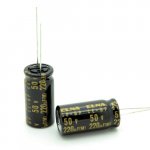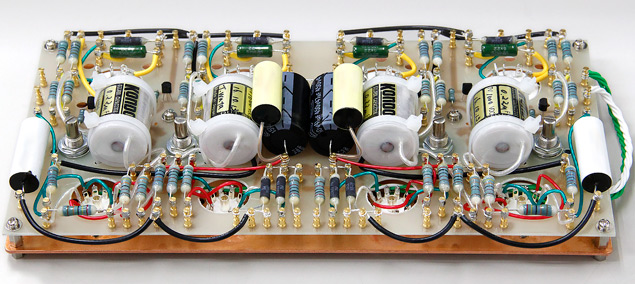We're on the same page Blitz. We all strive to make our system as transparent as we can & yet making sound as realistic to our ears as possible. Hence the whole system from source to speakers has to work in synergy. We can't escape from not having components affecting sound. The better way to look at this is to understand the sonic characteristic of each component, capitalize on it to tweak & balance out the sound that we're looking for.
As for me say capacitors, I never use 1 brand or 1 type rather I use different caps or brands for different locations. What caps I want to use I already know its signature but that does not mean it'll sound perfect wherever I place them, for this reason I would have to test with different caps to hear its effect. Needless to say it is a very long & tedious way but for me this is the only way to achieve what Im looking for. There's no such thing as 1 cap for all, what sounds good at 1 location may only be so so on another.
Cheers
As for me say capacitors, I never use 1 brand or 1 type rather I use different caps or brands for different locations. What caps I want to use I already know its signature but that does not mean it'll sound perfect wherever I place them, for this reason I would have to test with different caps to hear its effect. Needless to say it is a very long & tedious way but for me this is the only way to achieve what Im looking for. There's no such thing as 1 cap for all, what sounds good at 1 location may only be so so on another.
Cheers
... try out the Shindengen D4SBN20 or D6SBN20 bridge diodes. Smooth & grainless ...
Good tips. Thx.
when I build Mr Pass Boz preamp one was point to point they other build on pcb for a friend parts all the same on both, guess what, the point to point just sounded smoother & better, can't explain
Was it the same layout and did you keep pictures of both?
silvered mica, polysterene caps....for feedback duty..
Not that one. The one around 220uF
Okay, thank you Salas. That one is not expensive, hopefully I can find it (locally). And better than my current stock which is Elna RJH.
BTW, I have several NP/BP (most popular is the green Nichicon Muse-BP) but they are not better than RJH.
Last edited:
Unless you are prepared to put in a lot of design time designing a PCB component & tracks layout old school point to point wiring will always be superior .
Time after time what looks good on equipment tests and sounds good in a "lash-up " doesn't reproduce the same results when a "beautiful " layout of components and compromise PCB tracks are made .
Small compensation capacitors are required that weren't required when a hard wiring prototype is made this was always the case years ago but now its- click-a-key and "voila " -a ready virtual layout ---funny it usually requires adjusting even in this day & age .
When doing it in the real world young people learn more about to to position this or that component next to another or route a wire a different way -- that's called Practical learning in design layout as it goes the way of the Dodo due to either laziness or lack of layout knowledge.
As a consequence DIY Audio is filled with -- "well it worked and looked okay on my virtual audio software lash up why is it oscillating etc when I actually build it" ?
Nothing wrong with a modern app giving a helping hand but beware your software isn't an "audio god "
its -shock-horror its --fallible.
Time after time what looks good on equipment tests and sounds good in a "lash-up " doesn't reproduce the same results when a "beautiful " layout of components and compromise PCB tracks are made .
Small compensation capacitors are required that weren't required when a hard wiring prototype is made this was always the case years ago but now its- click-a-key and "voila " -a ready virtual layout ---funny it usually requires adjusting even in this day & age .
When doing it in the real world young people learn more about to to position this or that component next to another or route a wire a different way -- that's called Practical learning in design layout as it goes the way of the Dodo due to either laziness or lack of layout knowledge.
As a consequence DIY Audio is filled with -- "well it worked and looked okay on my virtual audio software lash up why is it oscillating etc when I actually build it" ?
Nothing wrong with a modern app giving a helping hand but beware your software isn't an "audio god "
its -shock-horror its --fallible.
You are listening to the power supply. So I consider the entire power supply in the signal path.
That is so true...I spend years to learn how much of a difference the PSUs of my tube amps make without changing the actual circuits...
I think Peter Daniel posted a link to an article of Jonathan Carr, the developer of Lyra Audio on the Super-Through...in that article Jonathan as well referred to his experience of using amorphous power transformers...(better than any R-xformer in his experience)
...which I tried as well (without knowing the article). But I agree with him: They are as audible as amorphous chokes, amorpous IT or OPT. Next chapter will be Power Xformer with a Nano core and OCC wire...
Last edited:
Was it the same layout and did you keep pictures of both?
Unfortunately not. It's been like 20 yrs ago.
Now I've learn something new too, with P to P the gauge of the wires used on different locations affects the sound too. Sigh where is it going to end. LOL
You are listening to the power supply. So I consider the entire power supply in the signal path.
This is so so true. When ppl comment power supply is not in way they either have not build or experimented enough. For starters I never use Toroid after 1 test I made many years ago, they just don't sound as good as EI & now that its been dscovered that Toroids are wide band we have part of the answer. If possible I always try to get Split Bobbins type. Heard that R Cores are good too but have not tried it yet.
Yes, indeed (cable diameter)...do you know Rob's Blog ?
"For about 80% soundquality is determined by the optimal diameter of the core and not the choice in material."
DHTRob - Guidelines for optimizing sound qualities of tube amplifiers
"For about 80% soundquality is determined by the optimal diameter of the core and not the choice in material."
DHTRob - Guidelines for optimizing sound qualities of tube amplifiers
Unless you are prepared to put in a lot of design time designing a PCB component & tracks layout old school point to point wiring will always be superior.
4 layer costs 20 EURO now...
" from kind of combining luck! "
...or knowing which component does what to your sound...which is a lot of work A/B-testing with a lot time to invest...was it Kondo or Sakuma who said the ciercuit is not so important, but the knowledge of the materials you use is ?
But I like Nelson's PAss design philosophy...just use minimal amount of components...as few as possible as each does something to the sound.
Example: I dont have a resistor in my amps as I even could spot the sound of Texas Components Z-foil, let a lone Mills WW or AN Tantalum. They all eat up musical energy and the material used for them are not at the level of a OCC copper wire. Use tubes and IT (really good iron with Nano cores) which you can run without them. Than there are not a lot P2P left anyhow and I would not know for what I want to use a pcb....
...or knowing which component does what to your sound...which is a lot of work A/B-testing with a lot time to invest...was it Kondo or Sakuma who said the ciercuit is not so important, but the knowledge of the materials you use is ?
But I like Nelson's PAss design philosophy...just use minimal amount of components...as few as possible as each does something to the sound.
Example: I dont have a resistor in my amps as I even could spot the sound of Texas Components Z-foil, let a lone Mills WW or AN Tantalum. They all eat up musical energy and the material used for them are not at the level of a OCC copper wire. Use tubes and IT (really good iron with Nano cores) which you can run without them. Than there are not a lot P2P left anyhow and I would not know for what I want to use a pcb....
- Home
- Design & Build
- Parts
- Best electrolytic capacitors

